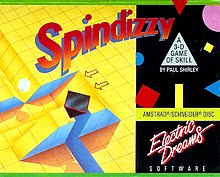| Spindizzy | |
|---|---|
 Amstrad cover depicting the player controlled probe (GERALD) on an isometric grid. | |
| Developer(s) | Electric Dreams, Loriciels (Thomson) |
| Publisher(s) | Electric Dreams, Activision |
| Designer(s) | Paul Shirley |
| Platform(s) | Amstrad CPC, Apple II, Atari 8-bit, Commodore 64, Enterprise 128, Thomson, ZX Spectrum |
| Release | 1986 |
| Genre(s) | Puzzle |
| Mode(s) | Single-player |
Spindizzy is an isometric video game released for several 8-bit home computers in 1986 by Electric Dreams Software. It combines action and puzzle video game elements. Players must navigate a series of screens to explore a landscape suspended in a three-dimensional space. Development was headed by Paul Shirley, who drew inspiration from Ultimate Play the Game games that feature an isometric projection.
The game was successful in the United Kingdom and was well received by the video game press. Reviewers praised its visuals and design, but criticized its audio. Similarities were drawn to Marble Madness, which was released in arcades two years earlier. Spindizzy was followed by a 1990s sequel titled Spindizzy Worlds.